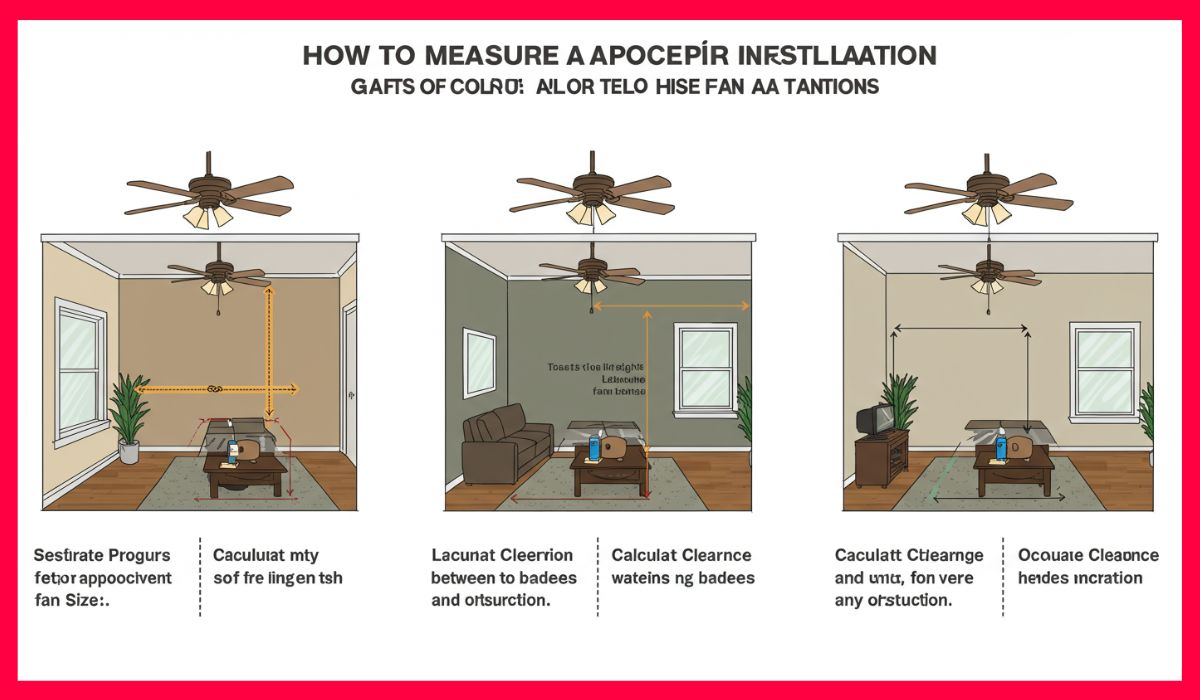So, you’re thinking of adding a ceiling fan to your space — maybe to beat the heat or just jazz up the air circulation, right? But before you rush out to pick a fancy fan that looks good on Instagram, there’s this sneaky, often overlooked step: measuring your room properly.
Yep, sounds simple, but trust me, it’s more than just whipping out a measuring tape and eyeballing it. Getting this right means better air circulation, energy efficiency, and that perfect fan blade span that makes your room feel like a fresh breeze on a hot summer day.
Let me take you on a little journey through the nitty-gritty of room measurement, fan sizes, and all the geeky stuff that’ll make your ceiling fan installation not just a breeze, but a cool breeze. Grab your measuring tape (or laser measure if you’re fancy), a notepad, a pen, and maybe a helper — because trust me, some measurements just don’t like to be taken alone.
Why Measuring Your Room Matters More Than You Think
Alright, before we dive into all the numbers and tools, let’s pause for a sec. Ever had a fan that felt like it was just blowing hot air? Or one that looked like a giant spaceship but did squat for cooling? That’s usually because the fan size wasn’t matched with the room size (square footage) or the ceiling height wasn’t considered.
The thing is, fan blade span isn’t just a fancy term—it directly impacts how well air circulates and how efficiently energy’s used. Too small a fan in a big space? Your energy bills spike, and comfort dips. Too big a fan in a tiny room? It’s like waving a giant paddle in a bathtub — just awkward and overkill.
So, measuring your room accurately is the secret sauce to getting the right fan — whether you need a flush mount ceiling fan for a low ceiling or a downrod length that suits your lofty vaulted ceilings.
Tools You’ll Need to Measure a Room for a Ceiling Fan
Before you get your hands dirty (or tape sticky), let’s talk gear. Here’s your measuring dream team:
- Measuring tape (the classic, reliable choice)
- Laser measure (for those high-tech vibes and tricky corners)
- Notepad and pen (write it down — don’t trust memory here)
- Calculator (because math is real, even if it’s just multiplication)
- Ladder (to get up close and personal with the ceiling)
- Helper (someone to hold the tape or laser steady — it’s a two-person game sometimes)
With these tools, you’re prepped to measure anything from a cozy bedroom to an irregular shaped room or even that tricky L-shaped room that’s got you stumped.
Step 1: Measuring Length and Width for Square Footage

The most basic, but essential step: find your room’s length and width in feet (ft). This will help you calculate the square footage, which is key to picking your fan size.
- Start by measuring one wall from corner to corner (length).
- Next, measure the adjacent wall (width).
- If your room’s perfectly square or rectangular, just multiply length × width for square footage.
What if your room is funky-shaped? No worries, just break it down into smaller rectangles, measure each separately, and add those up. For example, that L-shaped room can be two rectangles stuck together. Measure each rectangle’s length and width, get their areas, and add them up for total square footage.
Step 2: Measuring the Ceiling Height — Don’t Skip This!
Now, this one’s crucial for fan installation. You need to know your ceiling height because it affects your fan’s downrod length and whether you need a low-profile ceiling fan or a standard one.
Grab your ladder and measure from the floor straight up to the ceiling in feet or inches. If you’ve got vaulted or sloped ceilings, measure the highest point and the lowest point separately, because this’ll help determine if you need an angled mount or special installation accessories.
Here’s a quick guide:
- Ceiling height under 8 ft? Opt for a flush mount ceiling fan.
- 8 to 9 ft? Standard fans with a short downrod usually work.
- 10 ft or higher? Longer downrods for better airflow and safety.
Step 3: Understand Fan Blade Span and Why It’s a Big Deal
You’ve heard of fan blade span, but what exactly is it? It’s the diameter of the circle created by the spinning blades — basically, how wide your fan’s wingspan is.
The right fan blade span recommendations are based on your room’s square footage:
- Up to 75 sq ft (think small bathrooms or closets): 29-36 inches
- 76 to 144 sq ft (small bedrooms or kitchens): 36-42 inches
- 144 to 225 sq ft (average bedrooms, dining areas): 44-50 inches
- 225 to 400 sq ft (large living rooms, great rooms): 50-54 inches
- Over 400 sq ft (open-concept spaces or large rooms): multiple fans or fans with 56 inches or more
Choosing the correct span improves air circulation and energy efficiency, meaning better comfort and lower utility bills. Also, the fan blade pitch (usually between 12-15 degrees) impacts how much air the fan moves — steeper pitch, more airflow!
Step 4: Account for Room Shape and Obstacles

Not all rooms are square and simple. You might have a space with nooks, sloped ceilings, or even built-in shelves that block airflow. These details affect fan placement and size.
If you’ve got an irregular shaped room, measure each section separately and consider multiple fans in large rooms or special fan types like outdoor ceiling fans if the space extends outside. If there’s a beam or fan obstruction, you’ll want to make sure the blades won’t bump into anything, which might mean a smaller fan or a fan with shorter blades.
Step 5: Factor in Fan Types and Installation Accessories
There are so many fan options these days:
- Standard ceiling fan: Classic, works for most rooms.
- Low-profile or flush mount fans: Perfect for rooms with low ceilings.
- Fans with lights: Kill two birds with one stone — lighting and air circulation.
- Outdoor ceiling fans: Built for patios and humid conditions.
- Fans for vaulted/sloped ceilings: Usually need an angled mount.
Your measurements will dictate which fan type fits best. Don’t forget to consider the downrod length chart — too long or too short can mess with your airflow and the fan’s safety.
Read This Blog: https://mozydash.com/how-long-is-10-inche/
Step 6: Calculating and Choosing the Perfect Fan Size
Here’s where your measurements become your best friend. You’ve got your room’s square footage, ceiling height, and room shape details. Now match those to a fan size that maximizes comfort.
Here’s a little cheat sheet to keep in your pocket:
- Small rooms (under 75 sq ft): 29-36 inch blade span
- Medium rooms (up to 225 sq ft): 44-50 inch blade span
- Large rooms (over 400 sq ft): 52-60 inch blade span, or consider multiple fans
Pro tip: If you have Energy Star rated ceiling fans, they often have better motors and blade designs, improving energy consumption and reducing your environmental impact.
Step 7: Final Checks Before Installation

Before you commit, double-check:
- The optimal fan placement height — ideally 7-9 feet above the floor.
- If you have hotspots or drafts, make sure the fan placement helps balance the airflow.
- Your room obstacles affecting fan performance — furniture or fixtures that might interfere.
If your ceiling is lower or uneven, look for flush mount ceiling fans for low ceilings or fans designed for vaulted/sloped ceilings.
Why Proper Ceiling Fan Sizing Saves Money and Boosts Comfort
Picking the right fan isn’t just a matter of style; it’s a long-term investment in your home’s comfort and your wallet. Properly sized fans improve temperature regulation, reduce reliance on AC, and cut down motor wear and tear since the fan isn’t struggling to move air in an unsuitable space.
One homeowner, Lisa, shared, “I didn’t realize my fan was too small for the room until summer hit hard. Switching to a properly sized fan made a world of difference — my room felt cooler, and my energy bills actually dropped!”
Conclusion
Measuring your room for a ceiling fan might feel like a chore, but it’s the first step to turning your space into a comfortable, energy-efficient haven. With the right tools, a bit of patience, and attention to detail, you’ll nail the perfect fan size and installation setup — whether for your cozy bedroom, expansive great room, or breezy patio.
Remember, good air circulation starts with good measurement. And the joy of that cool breeze? Priceless.
If you’ve got stories about your own ceiling fan adventures or tips on measuring tricky spaces, drop ‘em in the comments below — I’d love to hear how you made your room feel just right

Rober max seo expert



